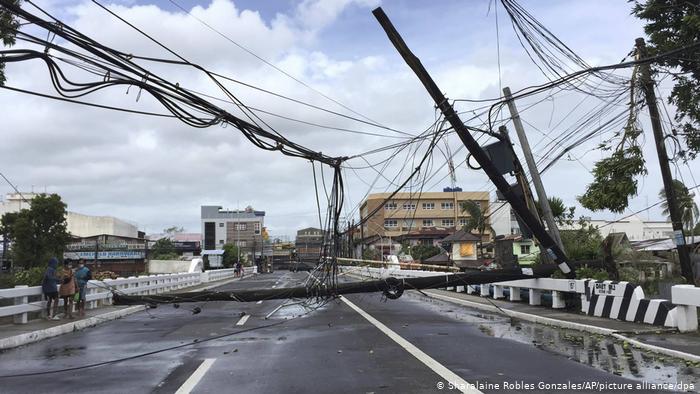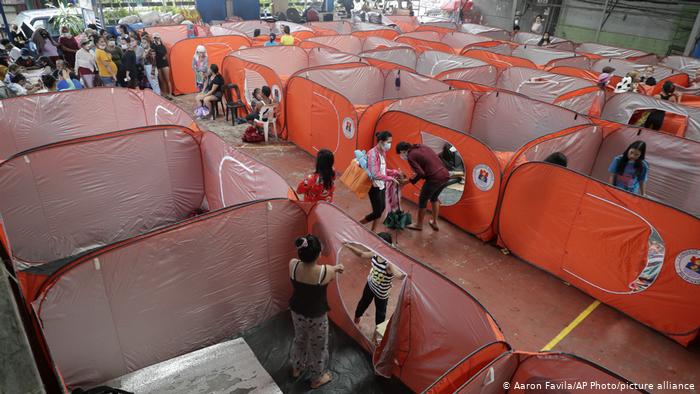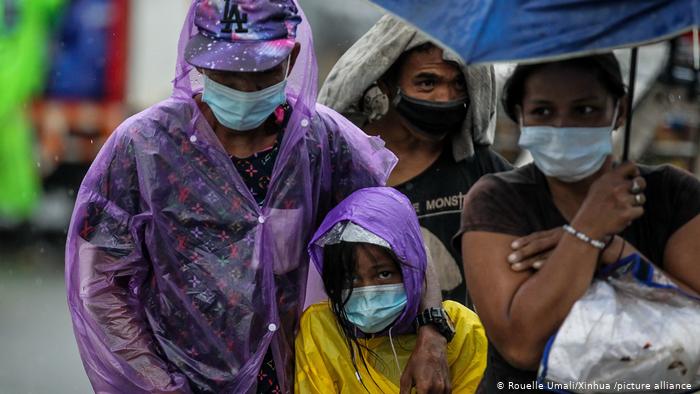
Audio By Carbonatix
Power and telephone lines are down and thousands of homes have been destroyed after the storm battered two provinces in the North of the Philippines. The Red Cross says it is "horrified" by the devastation.
At least 16 people are now known to have died after Typhoon Goni swept across the Philippines this past weekend, officials said on Monday.
It is the most powerful storm to hit the country since Typhoon Haiyan killed more than 6,000 people in 2013.
Catanduanes Island and nearby Albay province on the most populous island of Luzon in the north of the country were the worst affected areas.
Sustained wind speeds reached 225 kilometers (140 miles) per hour when Goni slammed into the east coast on Sunday.
Ferocious winds and torrential rain toppled power lines, triggered flooding and sparked landslides. Over 100 houses were buried by mudflows in the town of Guinobatan — with three people reported missing, local officials said.

Power and communication lines have also been cut off, according to local authorities.
The storm lost intensity as it skirted the capital Manila before heading out to the South China Sea. Typhoon Goni is forecast to hit the Central coast of Vietnam on Wednesday night.
Evacuations 'reduced' casualties
Civil defense chief Ricardo Jalad said approximately 347,000 people have been evacuated, revising down the one million figure he mentioned ahead of the storm.
Officials also noted that the pre-emptive evacuations likely helped to minimize the death toll from the storm.
"The goal should be zero casualties, but since people were forcibly evacuated our casualties were reduced," Harry Roque, a spokesman for Philippine President Rodrigo Duterte, told a news conference
President Duterte is to fly to Manila from his southern hometown of Davao for an aerial inspection of some of the worst-hit areas, Roque added.
'Horrified by the devastation'
Philippines Red Cross chief Richard Gordon said that the humanitarian organisation was "horrified by the devastation" caused by Tyhpoon Goni.

"Up to 90% of homes have been badly damaged or destroyed in some areas. This typhoon has smashed in to people's lives and livelihoods on top of the relentless physical, emotional and economic toll of COVID-19," he said in a statement.
The Philippines is hit by an average of 20 storms and typhoons every year. At least 22 people died when Typhoon Molave barreled through the same region last week.
But this year the COVID-19 virus has hampered any preparations. The virus has caused 380,739 infections and led to 7,221 deaths in the Philippines.
Latest Stories
-
Ghana is rising again – Mahama declares
5 hours -
Firefighters subdue blaze at Accra’s Tudu, officials warn of busy fire season ahead
5 hours -
New Year’s Luv FM Family Party in the park ends in grand style at Rattray park
5 hours -
Mahama targets digital schools, universal healthcare, and food self-sufficiency in 2026
5 hours -
Ghana’s global image boosted by our world-acclaimed reset agenda – Mahama
6 hours -
Full text: Mahama’s New Year message to the nation
6 hours -
The foundation is laid; now we accelerate and expand in 2026 – Mahama
6 hours -
There is no NPP, CPP nor NDC Ghana, only one Ghana – Mahama
6 hours -
Eduwatch praises education financing gains but warns delays, teacher gaps could derail reforms
6 hours -
Kusaal Wikimedians take local language online in 14-day digital campaign
7 hours -
Stop interfering in each other’s roles – Bole-Bamboi MP appeals to traditional rulers for peace
7 hours -
Playback: President Mahama addresses the nation in New Year message
8 hours -
Industrial and Commercial Workers’ Union call for strong work ethics, economic participation in 2026 new year message
10 hours -
Crossover Joy: Churches in Ghana welcome 2026 with fire and faith
10 hours -
Traffic chaos on Accra–Kumasi Highway leaves hundreds stranded as diversions gridlock
10 hours

